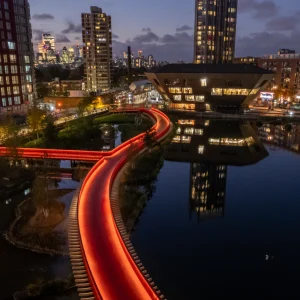Interior design has long been a popular career choice for women, but when it comes to architecture and particularly the engineering side of it, female role models are harder to find. It’s an imbalance that Michelle McDowell, chair of civil and structural engineering at interdisciplinary design practice BDP, is keen to see redressed. ‘I’m very happy to be thought of as a role model for other women and to show that there are routes through the industry right up to board level,’ she says.
And it would be hard to find a more formidable role model. At the top of her career, McDowell has just been made a MBE in the Queen’s birthday honours for services to the construction industry. ‘I’m absolutely delighted,’ she says of the honour. ‘It came out of the blue. I feel quite humbled by the whole thing because, in my working life, there are lots of people who do wonderful things and I think I’m just lucky to be honoured.’
But there’s obviously a lot of hard work behind that ‘luck’. McDowell has more than 25 years of experience in the engineering profession and has been instrumental in developing BDP’s interdisciplinary approach, getting architects and engineers working together from the beginning of projects. She has been heavily involved in many of BDP’s hugely successful city academy developments and has also worked on landmark projects including the renovation of the Royal Albert Hall and award-winning offices for the BBC and Roche.
Earlier this year McDowell was shortlisted for the First Women Awards, which recognise female pioneers in British business, professional and public life. Does she see herself as a glass-ceiling breaker?
‘I don’t really think of myself as that,’ she says. ‘I’m just getting on with my career and have been fortunate to be promoted. I’m happy to be thought of as a role model, but I’m not setting out to be a pioneer.’ So does she think there a glass ceiling in the engineering and construction industry, or do women just want to do other things?
‘It’s probably a bit of both,’ she says. The image of the construction industry needs to change a bit to attract women. I think sometimes woman do face difficulties; generally we tend to do things in a different way from men, I believe, and have different ways of approaching things. In a male environment, it can be difficult for women to get themselves heard. But if you look around our office, you’ll see that it’s a great environment for men and women to work in.’
In January this year, McDowell became chair of the Association for Consultancy and Engineering (ACE). The role involves working with the chief executive, Nelson Ogunshakin, and to be the business voice of the construction and engineering industry. ‘We represent about 100,000 engineers and consultants. It’s about influencing Government policy to create good appointment terms for consultants and engineers. It’s also about nurturing the business skills of young people so that they can work their way up in the industry and become leaders,’ she says.
Engineering doesn’t have as glamorous a profile as architecture, but according to McDowell, engineers have a unique opportunity to make a difference to the way we all live. ‘For me, one of the big things now is carbon reduction and trying to achieve the carbon-reduction targets. Engineers, I believe, are uniquely placed to address that through design and construction.’
But can engineering be a creative role?
‘Absolutely. The model that we have at BDP is that we’re integrated architects, engineers and designers, so an engineer will sit down with an architect and a blank sheet of paper and begin to shape the building. While the architect has a vision about the building’s form, we engineers will shape the building around the site constraints. In terms of opportunity for creative and innovative thinking, it’s all there.’
Integrating the roles of architect and engineer is something BDP is particularly proud of and, with strict legislation governing environmental sustainability, this approach is more important then ever. ‘The other model is where an architect will develop their ideas to a certain extent and then ask an engineer to make it work. You don’t get such a good building that way,’ says McDowell. ‘If you’re thinking together from the start, you can actually be more innovative and the engineer can bring their influence to bear so you actually end up with a better design – perhaps more efficient, more cost-effective and easier to build. The projects we do that way at BDP tend to be the award winners.’
One such project was the broadcasting centre BDP designed for BBC Birmingham in the city’s Mailbox building. The building had high ceilings but lacked floor space, and the solution was to create a mezzanine level. ‘We had to design a really lean structure that would be strong and which wouldn’t bounce when people walked on it, but which could provide the initial office accommodation that was needed. We did that by working closely with our architects and doing lots of structural analysis and design,’ says McDowell. ‘Our company ethos is “beacons not icons”, so we don’t want to impose a design on a child in school or a patient in hospital; it’s very much about shaping the building around what they need. And that means you end up with buildings that work well for the purpose for which they’re designed.’





